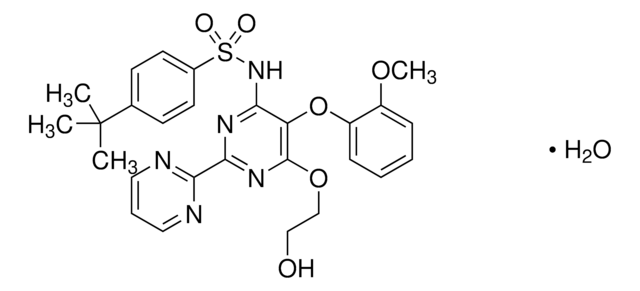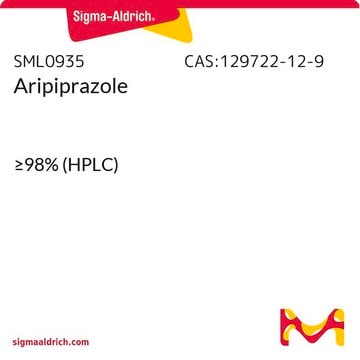SML2574
Candicidin
≥50% (HPLC)
Synonim(y):
Candicidin, Candeptin, Candimon, Levorin, Vanobid
Zaloguj sięWyświetlanie cen organizacyjnych i kontraktowych
About This Item
Wzór empiryczny (zapis Hilla):
C59H84N2O18
Numer CAS:
Masa cząsteczkowa:
1109.30
Kod UNSPSC:
51111800
NACRES:
NA.77
Polecane produkty
pochodzenie biologiczne
Streptomyces griseus
Postać
solid
warunki przechowywania
protect from light
stężenie
≥50% (HPLC)
rozpuszczalność
DMSO: 1 mg/mL
temp. przechowywania
−20°C
Szukasz podobnych produktów? Odwiedź Przewodnik dotyczący porównywania produktów
Opis ogólny
Candicidin is a polyene macrolide antifungal antibiotic which inhibits large number of fungi. 2 Polyene antifungal antibiotics, such as Candicidin, specifically target cell membranes containing sterols. Thus, selectively targets variety of prokaryotic organisms (such as Candida albicans) and not eukaryotic organisms. Candicidin generates cell membrane damage to Candida albicans (C.albicans) by triggering a rapid efflux of K+ ions. Interestingly, it was found that dosage needed for Candicidin to inhibit growth of stationary phase C. albicans cells is 25 μg/ml whereas log-phase C. albicans cells is only 5 μg/mL. In 1953 Kigman and Lewis performed the first in vivo study with mice to reveal the effects of Candicidin. Their study showed that Candicidin exhibits protective effect against C. albicans, Blastomyces dermatitidis and Sporotrichum schenkii but only a partial protective effect against torulosis and histoplasmosis. LD50 for Candicidin oral administration and intraperitoneal administration in mice were 90-400mg/kg and 2.1-7.0 mg/kg respectively. When comparing the activity of Candicidin to other antifungal compounds in vivo protects 100% of mice with C. albicans infection, whereas usage of twice the amount of Nystatin protects only 60% of the mice. Candicidin may undergo a photoisomerization process, yielding all-trans derivatives of Candicidin when exposed to direct UV light.
This page may contain text that has been machine translated.
Kod klasy składowania
11 - Combustible Solids
Klasa zagrożenia wodnego (WGK)
WGK 3
Temperatura zapłonu (°F)
Not applicable
Temperatura zapłonu (°C)
Not applicable
Certyfikaty analizy (CoA)
Poszukaj Certyfikaty analizy (CoA), wpisując numer partii/serii produktów. Numery serii i partii można znaleźć na etykiecie produktu po słowach „seria” lub „partia”.
Masz już ten produkt?
Dokumenty związane z niedawno zakupionymi produktami zostały zamieszczone w Bibliotece dokumentów.
Nasz zespół naukowców ma doświadczenie we wszystkich obszarach badań, w tym w naukach przyrodniczych, materiałoznawstwie, syntezie chemicznej, chromatografii, analityce i wielu innych dziedzinach.
Skontaktuj się z zespołem ds. pomocy technicznej








